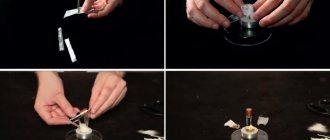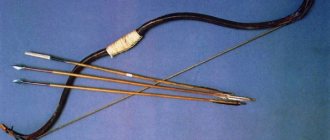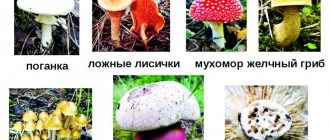Fragrant plant resins are substances of natural origin, organic polymer compounds that have a characteristic odor and good viscosity. When they freeze they become hard. Resins are widely used for the preparation of cosmetics. Production of perfumes, soaps, detergents, fresheners, and other products for hygiene, home improvement. Often used as incense during aromatherapy and other healing rituals. Due to their biologically active properties, fragrant compounds are widely used in folk medicine and are used to treat external and internal diseases. How are they mined? It is collected by natural extraction from plants, or by mechanically forcibly cutting the bark of trees.
Composition, biological activity
Resins belong to the category of energetic organic compounds, where the main components are diterpene compounds and cyclic acids. Also present are esters of resin acids, alcohols, tannins, hydrocarbons, phenols, etc. The substances are non-volatile, have high viscosity, and are soluble in alcohols and other organic and inorganic solvents. As for the connection with other components, they are mainly present in combination with essential oils.
Resins are considered one of the few natural creations that can protect and save from all diseases. That is why they are often called resin, that is, living substances filled with vitality. The amazing longevity and strong biological activity of resins is explained by their unique natural properties.
- Resinous substances are considered one of the compounds most resistant to negative environmental factors.
- It has a depressing effect on pathogenic microflora of any origin. All thanks to the fact that they have pronounced antiseptic and antibacterial properties that last for thousands of years.
How do you get plant resin? By collecting from trees, sources of the most valuable natural product.
Making glue
Only when you need glue and you are in the forest, pine resin will be the starting point for its creation.
You will need:
- Large pieces (lumps) of resin.
- Charcoal, you can take it from the fire.
- A mass made from crushed dry plants.
Collect resin, i.e. The first and most important component can be from different coniferous trees, but keep in mind that resin from different trees has a different consistency and unique properties, so you will need to experimentally achieve the optimal formula for preparing glue from the ingredients. Charcoal has wide applications for extreme situations and survival. It can be used to camouflage objects, camouflage, purify water, for medicinal purposes, and to create adhesives. Pieces of dried charcoal (a product of incomplete combustion of wood) can easily be found in the remains of a cooled fire.
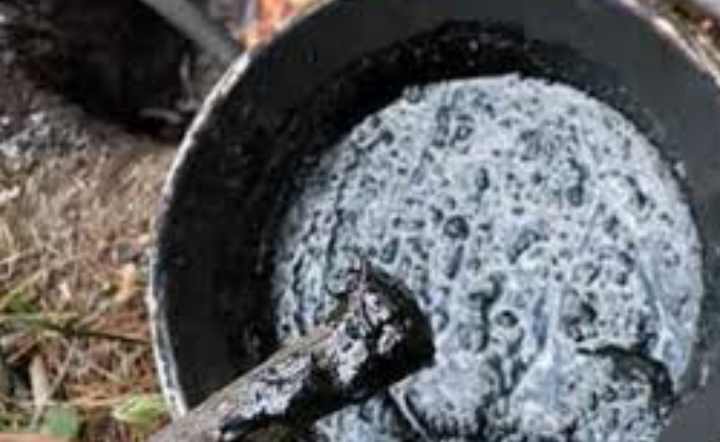
The glue will actually be more effective if it has a bonding layer. Plant-based fibrous material is ideal for this, but keep in mind that it must be fine. The waste products of herbivores cannot be excluded from the list of components for use. Instead of using time and energy to collect and shred leaves and dry grass, you can let animals (deer, elk and rabbits) do all the work for you. These animals are herbivores, that is, they eat plants, and usually do not eat meat at all.
Plant buds, leaves and grass are all things that are difficult to digest, so herbivores must definitely break them down and grind them so that the work of the stomach is facilitated to the maximum. In both humans and herbivores, the concentration of hydrochloric acid in the stomach is 10 times weaker than in carnivores, so the digestive process will begin in the mouth, with the help of a special enzyme ptyalin, which helps in the breakdown of starch and polysaccharides, which are very abundant in plant foods.
To grind ingredients and create glue based on resins, herbs and charcoal, use a flat stone for the base and a rounded stone to grind the charcoal and plant material. It may take a little more effort and time, but if you can crush everything into a powder, then everything is great. Next you need to melt the resin. A Dakota hearth is a better choice for this and will be a better solution to the problem as it creates more heat, is easier to control and will produce less smoke with less wood.
Besides everything else, the Dakota hearth causes minimal damage to the environment, and this is an extremely advantageous position. You must be careful when heating the resin as the substance is flammable. So, if the flame is near the molten resin composition, the fumes can catch the fire and you will have to put out the fire. For this reason, it is better to melt the resin on hot coals, which will reduce the risk of ignition of the heated substance in the heating container. When everything is melted, you should thoroughly mix the ingredients, namely add charcoal and plant fibers.
The approximate ratio is as follows:
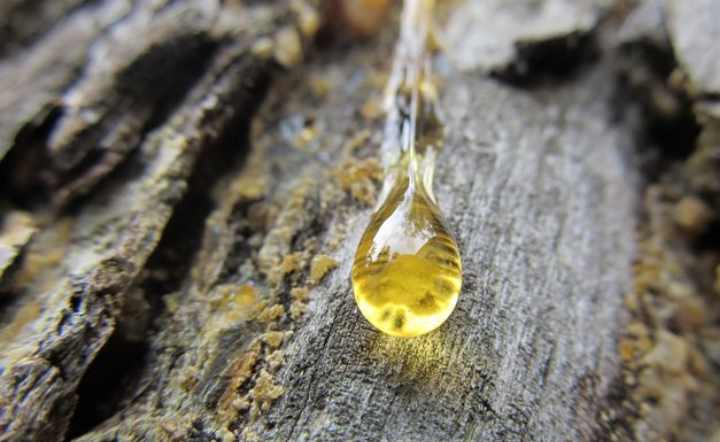
5 measures of melted resin.- 1 measure charcoal, ground into powder.
- 1 measure of plant material.
Once everything is mixed, the glue will become thick, black, tar-like and very sticky. You will see that the adhesive mass will begin to harden quickly when removed from the heat source and soften again after the heat is applied.
Using the glue is easy, you just need to roll it into a ball while it is pliable and warm, and as needed, warm up small areas and treat the surfaces you plan to glue. For best results, warm up the surfaces only before you use the adhesive to prevent it from hardening too quickly.
There are alternative recipes that can be used to make glue, and these include different combinations and ratios of charcoal, resin, plant materials, iron filings, sulfur, fur or hair, animal fats or beeswax. Depending on what ingredients and preferences you have, the materials can be used to make a good, strong adhesive for your home. The main component will still be pine tree resin, but recipes can be improved if you use the rich resources of nature.
Classification by extraction method, physical parameters, quality
Based on the method of extraction, substances are divided into several types:
- One type of resin is collected from natural, special cuts in the bark, from which an aromatic, sticky mass flows out, which is subsequently distilled.
- Another type of substance is collected in the form of a semi-hardened mass, which is mostly concentrated on the branches of resin-bearing plants. After collection, the branches are immersed in boiling water, where the resinous structures are detached.
According to physical indicators, substances are:
- Soft, which includes almost all species obtained from plants.
- Hard, like amber. Collected from several types of trees, such as cedar, larch, pine, and other conifers.
As for quality characteristics, substances are:
- The highest grade, collected from the very top layers, perfectly clean, free of foreign inclusions and impurities. They are used for fumigation, making incense, producing beauty products, and for medical purposes.
- II varieties, collected mainly from the middle layers. Contains impurities from tree bark, which falls during collection. They are used for incense, incense, and the production of natural cosmetics.
- III grades are not inferior in quality and medicinal characteristics to the previous ones. They differ in that they contain a large percentage of all kinds of impurities: bark fragments, dust, sand, grass, animal hair, parts of bird feathers. For purification and subsequent use, they require preliminary filtration.
Differences between resin and glue
There are big differences between glue and resin that reveal disadvantages that are unacceptable:
- The glue has a certain time to harden, which cannot be controlled in any way, but the hardening of the resin in its pure form can be accelerated.
- The resin can remain transparent for a long time, but the glue very quickly begins to turn yellow.
- Epoxy glue is not so elastic and hardens quickly, but the resin is much more pliable and you can work with it more carefully than in all other cases.
- Glue can only be used to connect parts, and resin is suitable for making beads and other figures of the required shape.
- Depending on the proportions that are used to mix the hardener and resin for the adhesive, you will be able to obtain the desired consistency that is ideal for your needs, and the adhesive can be purchased as a ready-made mixture.
In addition, epoxy glue can be made from resin. For the first time such a resin was obtained by a chemist from France, Castan. Currently, epoxy resin can be obtained from various epichlorohydrin compounds and organic compounds. This method is called "epoxidation". Valuable grades of epoxy-type resins can be obtained by performing catalytic oxidation of an unsaturated compound. For example, this is how cycloaliphatic resins are obtained, which are valuable because they do not contain hydroxyl groups, and therefore they are resistant to water, which has a positive effect when using the material for the home.
For practical use of resins, a hardener is required. It can be an anhydride or a polyfunctional amine, or other acids. You can also use catalysts for hardening. Once mixed with it, the epoxy resin will quickly begin to harden into an insoluble and infusible state. If you use PEPA, the resin can harden in 24 hours at room temperature, and anhydride-type hardeners will require 10 hours and heating to 180 degrees in a special thermal chamber.
Main types of plant resins
| Name | What plants are extracted from, properties |
| Incense | The oldest, most popular of the existing species. It is extracted from a tree growing on the Arabian Peninsula, in the countries of North Africa. When burned, it emits a rich, pleasant smell, which explains its widespread use for fumigating rooms, making incense sticks, and other incense. By the way, these products are sold in assortment here. Incense is also in demand in church rituals; it has long been used for Christian, Islamic, and Buddhist ritual ceremonies. It has also found application in perfumery and is added to various aroma compositions, hygiene products, and caring cosmetics. |
| Aloe | Due to its unique medicinal and cosmetic properties it is considered a valuable ingredient. According to the beliefs of many peoples, it is endowed with the ability to inflame passion, attract positivity, bring success in business, and prosperity to the home. If we talk about traditional medicine, aloe resin is widely used to prepare products that strengthen blood vessels, the heart, improve the condition of the skin, and increase local and general immunity. |
| Sandalwood | It is extracted from the trunk of the evergreen sandalwood tree, growing in Indonesia and India. Contains valuable components with antibacterial, antimicrobial, wound-healing effects. It has a pronounced pleasant aroma, is considered a natural aphrodisiac, and is widely used in aromatherapy, the incense industry, cosmetics, and medicinal purposes. |
| dug | Extraction is carried out from trees of the legume family, growing in Central and South America. Used in cosmetology, for ritual ceremonies, and for making incense. Before the production of synthetic polymer resins was established, copal was used to produce varnish for wood coatings. |
| Kedrovaya | It is extracted from Lebanese cedar, which is native to Lebanon. An analogue can be considered a similar substance extracted from cedar, growing in the Far East, in Siberia. It has a pronounced pleasant smell and is actively used in aromatherapy, classical and folk medicine. Used to produce camphor and turpentine. |
| Gopher | It is obtained from the Gopher tree, which has unique properties. The plant is considered one of the hardest, less susceptible to wormholes, rotting, and other damage than other species. Resin has been used since ancient times and is considered the best remedy for problems with the skin, inflammation, and infection of soft tissues. |
| Muira Pauma | Extracted from the wood of Lyriosma ovate, a crop native to South America. It is considered one of the strongest drugs that increases blood pressure and is a powerful stimulant of sexual function and the central nervous system. |
| Stacti, myrrh, | It is extracted from the trunk of a tree growing on the coast of the Indian Ocean, the Red Sea, and in the countries of the South African continent. The resin, which has a pleasant smell, has been considered very valuable since ancient times. Previously, it was especially in demand in Egypt, Rome, Greece, and European countries, as it was used for embalming and anointing the bodies of the dead. Today it is mainly used for fumigation of premises, rooms, sacred anointing, and other religious ceremonies. |
| Sandarac | It is obtained after cutting the bark of a crop whose habitat is Algeria, the vast expanses of North-West Africa. It is used for cosmetic and medicinal purposes, often for the production of plasters. |
| Benzoinaya | It is obtained from the trunk of the storax tree, the birthplace of which is Palestine. A reddish-brown thick, thick substance is widely used for ceremonies, rituals, incense, and the production of smoking powder mixtures. |
| Mastic | It is extracted from a plant called Pistacia Lentiscus, whose natural habitat is the Mediterranean countries and the coast of Africa. How is it used? In dentistry for filling teeth, in the treatment of stomatitis, gingivitis, in folk medicine, pharmacology - for the preparation of the strongest wound-healing ointments, mixtures, tinctures. |
| Finnish tree resin | It is obtained from a plant similar in appearance to cypress. It has a very pronounced aroma; it used to be worth its weight in gold, equal in value to precious stones. Valued for its aromatic properties and unique medicinal properties. |
| Amber | Conifer resin is formed over thousands of years during repeated oxidation followed by polymerization of wood resinous components. It has the strongest positive energy and is popular in cosmetology, traditional and alternative medicine. Suitable for water purification, it is considered the strongest antiscorbutic agent. Amber helps to cope with diseases of the respiratory and digestive organs, is useful for heart ailments, and obstructed urine flow. Due to its powerful antibacterial and antiseptic properties, it is used to treat asthmatic attacks, diseases of the gastrointestinal tract, and various external and internal suppurations. |
| Halavanskaya | It is extracted from the wood of the hawan plant. The natural habitat of the culture is Abyssinia, Syria, Arabia. The substance has a pleasant, pronounced aroma and is used for aromatic incense and the preparation of medicines. |
| Arabian juniper | It is extracted from a plant of the juniper family, growing on the Arabian Peninsula. For thousands of years it has been used for fumigation and the preparation of medicinal potions. |
Plum resin glue. There are streaks of resin on the drain, what should I do?
The first sign of trouble in a plum tree is the appearance of gum on its branches. There are many reasons causing this phenomenon. You just need to determine which of the misfortunes happened to your tree.
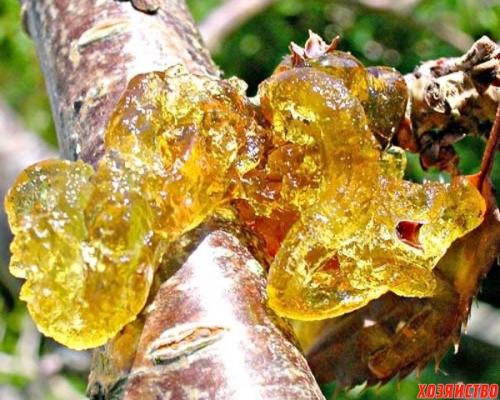
BARK BEETLE IS TO BLAME
The first thing to do is to pick off a couple of drops of resin. If you find small round holes on the wood underneath, it means that your garden has been visited by a bark beetle. This is a very unpleasant guest and it is difficult to get rid of him. First, cut and burn all affected branches. Then regularly water and feed the trees, and in early spring, spray the trees with Bi-58 solution at the first leaves, which can kill bark beetles traveling along the branches and boring into the bark.
Advice from the "Household"
You are more likely to cope with a bark beetle infestation if you have young, vigorously growing trees. And also if sanitary pruning and treatment of trees from pests and diseases is regularly carried out in the garden.
CARBONATE SOILS TO BLAME
If the garden is located in an area with carbonate soils, then plum trees may suffer from excess lime. The situation can be corrected by introducing decent doses of manure or acidifying mineral fertilizers in the form of superphosphate, potassium sulfate, etc.
Branches heavily covered with gum should be removed. Clean off any remaining stains and wash the wounds with copper sulfate: 10 g per 1 liter of water. If the gum continues to be released, the wounds are rubbed with sorrel leaves several times for 30 minutes.
FUNGAL DISEASES ARE TO BLAME
A strong release of gum can appear when plums or other stone fruit trees are infected with fungal diseases. In particular, coccomycosis or moniliosis. They are usually accompanied by drying out and flying leaves. If this happens, you need to urgently take action by planning three or four treatments with fungicides for the next year: Horus, Skor and copper-containing preparations.
IMPROPER CUT TO BLAME
Gum can also form due to improper or untimely pruning. It is therefore not surprising that in many countries plums and other stone fruit trees are shaped using green pruning in August. As a result, the wounds are small and the crown is easier to form.
In general, careful handling of stone fruit crops will allow you to avoid many of the causes of gum disease and, as a result, get a good harvest.
Use in folk medicine
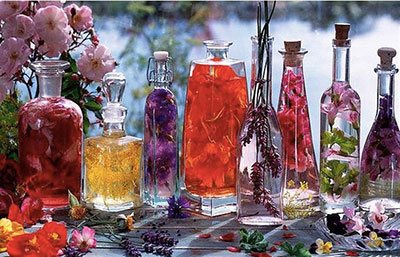
How are raw materials from tree trunks used in folk medicine and for home use?
- Added to relaxing, therapeutic and prophylactic baths that help with stress, nervous and physical exhaustion, and dermatological problems.
- They are dripped into household humidifiers and aroma lamps to freshen the air, creating an aromatic atmosphere that strengthens the immune system by eliminating bacteria and germs.
- They are added to toothpastes and oral hygiene products to prevent caries, periodontal disease, stomatitis, and to cope with diseases if they already exist.
- Used in cosmetics: creams, lotions, masks, tonics for problem skin of the face and neck, to prevent aging, fight acne, comedones, and other skin rashes.
- Add to massage oil to heal the body, normalize sleep, strengthen the immune system, and improve overall well-being.
Stamps
It is best to choose these 4 types of glue with quality characteristics:
"Cold welding".
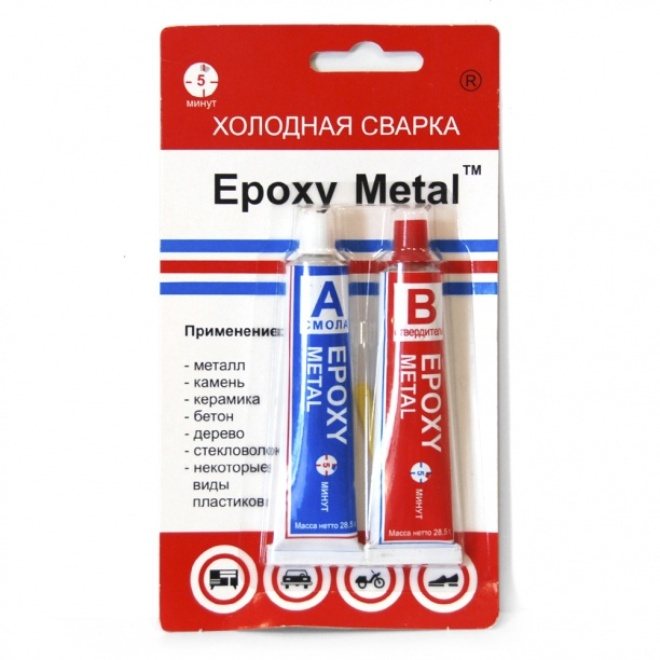
EDP.

"Contact".
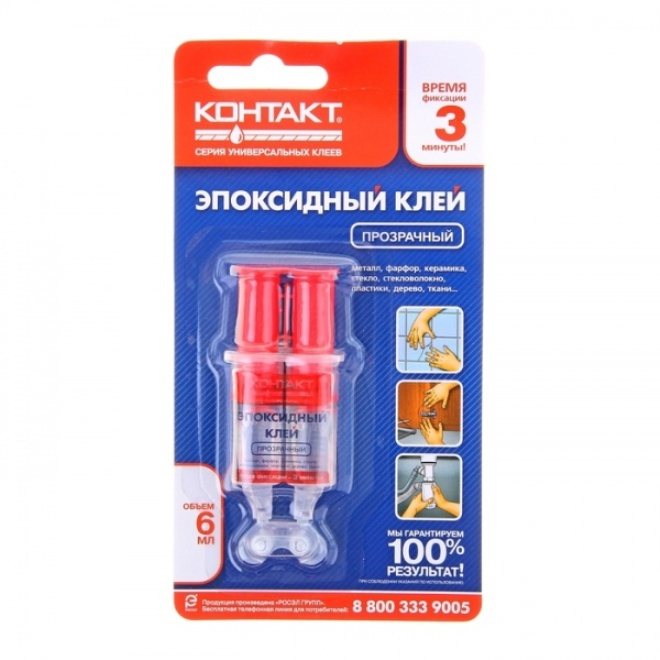
Glue "Moment" Epoxylin.
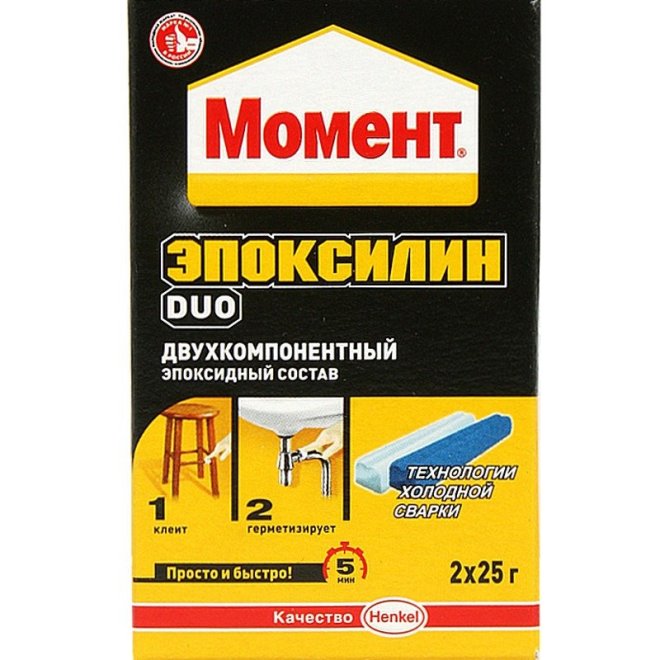
It is possible to determine which manufacturer will be better only experimentally and taking into account the main purpose and characteristics of the varieties.
“Cold welding” is produced by such manufacturers as Akapol, the Russian “Astat”, the “Anles” brand, and the Runway trademark. The epoxy composition EDP is suitable for working with various materials, produced by domestic companies, JSC Anles, LLC Ekoclass, Khimkontakt. Epoxy mortar “Moment” from the manufacturer Henkel is very popular, and the domestic one has also proven itself well. “Contact” allows you to work even with wet surfaces.
On video: EAF epoxy resin, tricks of use.
Useful tips for storing and using glue
- Do not use glue to repair items that come into contact with food.
- If glue gets on your skin, quickly wash the damaged area with soap and water. If irritation occurs, consult a doctor.
- If the resin or glue is difficult to squeeze out of the tube, then you need to warm it up - put it on a radiator or place it in hot water.
- To extend the shelf life of the glue, you need to pump out the air from the packaging and put the tube in the refrigerator.
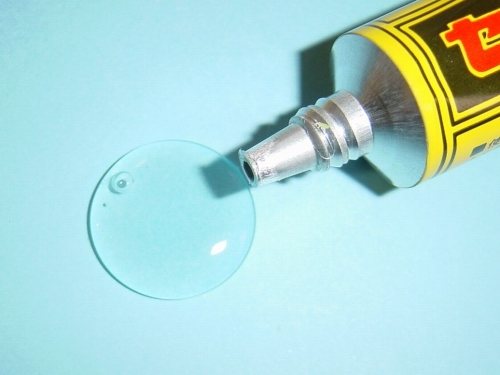
Types of material
Currently, more than a dozen brands of epoxy adhesive can be found on the building materials market, so it must be correctly classified in order to choose the best option for a specific type of work or for specific conditions. The criteria by which the types of adhesive resins are determined are composition, consistency and method of curing.
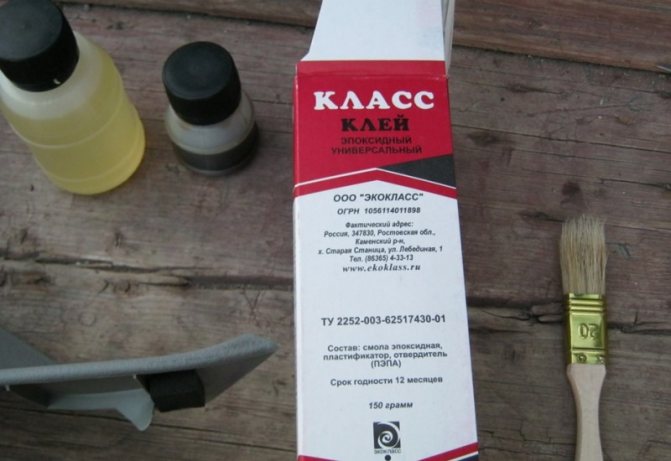
The composition classification defines two types of glue: one-component and two-component.
- One-component adhesive is sold in a sealed tube. This tube is filled with resin and solvent. No preliminary preparation of the composition is required. Due to the small volume of the tube, such adhesive compositions are intended for minor repairs or for sealing gaps and joints. But often one-component glue requires elevated temperatures to harden, although models are now being produced that set without preheating.
- At first glance, it seems that one-component adhesive has an advantage, however, two-component compositions are more often found on sale. The set includes two tubes. One of them contains a resin that has a paste-like consistency, and the other contains a powder or liquid hardener. Preparation of epoxy glue is reduced to mixing the contents of the tubes in the proportion specified by the manufacturer. The master must quickly prepare the composition and use it before curing, otherwise the adhesive ability of the resin will disappear.
Useful to know > What is jewelry epoxy resin and how to work with it
Separation by consistency defines two groups of epoxy resins: liquid and plastic. The liquid resin has a viscosity similar to fresh honey. It is squeezed out of a plastic or tin tube with little effort. The ability to dispense glue allows you to optimize its consumption. Plastic resin is similar to plasticine. It is sold in cylindrical containers and consists of two components that do not interact with each other during storage and transportation. To prepare the glue for work, you need to cut off the required amount of mass and knead it in your hand, while wetting it with water. As a result, the components will begin to interact, so the mixture should be immediately applied to the seam area.
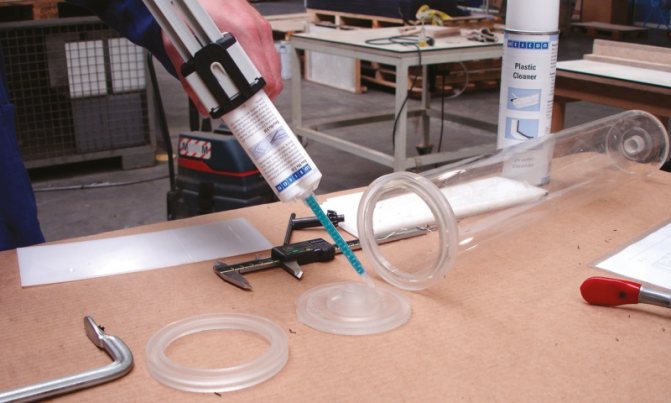
The curing process can occur in different ways. It all depends on the type of hardener used. If the adhesive consists of an aliphatic polyamide, epoxy resin and some plasticizers with fillers, then curing occurs at a temperature of 20°C degrees. The average reaction time is 24-72 hours. Such adhesive materials are more convenient to use, but with prolonged exposure to moisture they lose their properties. The quality of the connection deteriorates sharply when gluing parts made of hydrophilic materials, such as wood.
For modified compositions, the temperature for the curing process can reach 120°C degrees. Such materials are mainly used when working with non-metals and metals subject to shock loads. Hot-curing epoxy adhesive is resistant to oils and petroleum-containing products. The higher the curing temperature, the stronger the connection. Not only strength increases, but also heat resistance, as well as electrical insulation properties.



